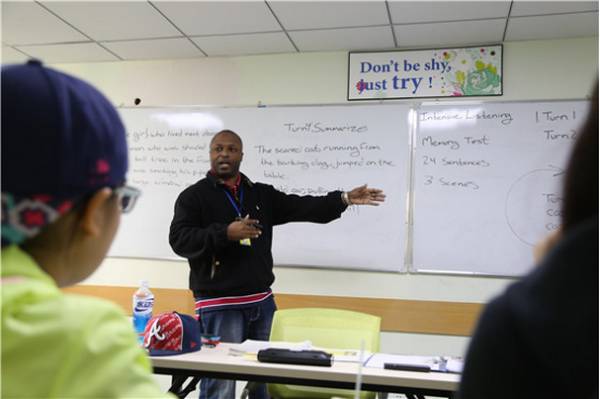- A+
??
英语语法重点与难点
?
1. as…as…结构:you’re a boy as good as tom.=you’re as good a boy as tom.你和汤姆是一样好的孩子。2.?(1) too…to与 so…that sb. can’t…的句型转换:前者为简单句,主语只有一个,而后者为复合句,主语有两个:the man was too angry to be able to speak.the man was so angry that he wasn’t able to speak.(2) too…to…与 not enough to句型的转换:he is too young to get married.=he is not old enough to get married.the book is too difficult for me to read.=the book is not easy enough for me to read.3. 形容词原级表示比较级含义:约翰不象迈克那么苯。john is not so stupid as mike.john is less stupid than mike.john is cleverer than mike.4. 用比较级表示最高级:约翰是班里最高的男生。john is taller than any other boy in the class.john is the tallest boy in the class.5. the more….. the more….表示“越……越……”:the more books you read, the wider your knowledge is.the more food you eat, the fatter you are.6. more and more….表示“越来……越……”:more and more students realized the importance of a foreign language.our country is getting stronger and stronger.
图片
?
词组
?
1. after, in??这两个介词都可以表示“……(时间)以后”的意思after 以过去为起点,表示过去一段时间之后,常用于过去时态的句子中如:she went after three days.?她是三天以后走的in 以现在为起点,表将来一段时间以后,常用于将来时态的句子中如:she will go in three days.?她三天以后要走2. how long, how often, how soonhow long指多长时间,主要用来对一段时间(如three days, four weeks 等)提问?如:how long ago was it??这是多久前的事了?how often指每隔多久,主要用来对频率副词或状语(如once a week等)提问?如:—how often does he come here? —once a month.?他(每隔)多久来一次?每月一次。how soon指再过多久,主要用来对表示将来的一段时间(in an hour, in two weeks 等)提问?如:how soon can you come??你多快能赶来?3. few, a few, little, a little, several, somefew 和little的意思是否定的,表示“很少”或“几乎没有”;而a few和a little的意思是肯定的,表示“有一些,有一点儿”few 和?a few修饰可数名词;little 和?a little 修饰不可数名词several用于修饰可数名词,语意比a few和some更肯定,含有“好几个”的意思some可修饰可数名词,也可修饰不可数名词,从数量上说,它有时相当于a few 或?a little,有时指更多一些的数量4. the other, anotherthe other 指两个人或事物中的“另一个”,表示特指?another着重于不定数目中的“另外一个”,表示泛指,所以常用来指至少三个中的一个?如:she has taken another of my books.?她已经拿了我的另外一本书5. spend, take, cost, payspend的宾语通常是时间?金钱?在主动语态中,句子的主语必须是人,而且后面不能用动词不定式做它的宾语?如:she spent the whole evening in reading.?她把整个晚上用来读书take常常用来指“花费”时间,句子的主语通常是表示事物的词语?如:how long will this job take you?你做这项工作要花多长时间?cost 指花费时间?金钱或力气等,只能用表示事物的词做主语,并且不能用于被动语态?如:how much does the jacket cost?这件夹克多少钱?pay 主要指主语(某人)买某物(或为某事)付多少钱(给某人)?如:i pay for my rooms by month.?我按月支付租金6. among, betweenbetween 的意思是“在……中间,在……之间”,一般指在两者之间?如:there is a table between two windows.?在两扇窗户之间有一张桌子。between 有时也表示在多于两个以上的事物之间,但那是指在每二者之间。如:the relationship between different provinces and municiplities?省市和省市之间的关系(这里是指每两个省市之间的相互关系?)7. beat, win这两个词都有“获胜,打败”的意思,但其后宾语不同?beat是“打败,优于”的意思,后面接人或队?如:we beat them.?我们打败了他们。win指“赢,获胜”,后面接比赛?名次?如:we won the match/game/race/the first place.?我们赢了这场比赛(获得了第一名)。8. agree with, agree toagree with表示“与……意见一致”,后面既可以跟表示人的名词或人称代词,也可以跟表示意见。看法的名词或what引导的从句?。如:i agree with you without reservation.我毫无保留地同意你的意见。we agree with what you said just now.我们同意你刚才所说的意见。agree to后面不能接人,只能接“提议,计划,方案”等词句?如:i agree to the terms proposed.?我同意拟议的条件。9. bring, take, carry,fetch这四个词都是动词,都含有“带”或“拿”的意思,但使用的场合各不相同。bring作“带来,拿来”解?如:next time don’t forget to bring me a copy of your work.?下次不要忘了把一份你的作品带给我。take是bring的对语,作“带去,拿去”解?如:take the box away, please.?请把盒子拿走。carry表示“运载,携带”之意,运送的方式很多,可以用车、船,也可以用手甚至用头。如:this bus is licensed to carry 100 passengers.?这辆巴士准载一百人。fetch则表示“去拿来”的意思。如:please fetch me the documents in that room.?请到那间房间去把文件拿来给我。10. each, every两词都是“每个”的意思,但着重点不同。each着重个别的情况,every着重全体,有“所有的”的意思。如:she knows each student of the class.她认识这个班里的每一个学生。she knows every student of the class.她认识这个班所有的学生。11. nonenone指“一个也没有(既可指人,也可指物)”,作主语时代替不可数名词,谓语动词用单数形式;代替可数名词,谓语动词用单、复数都可以。但在“主+系+表”结构中,如果表语为复数,则系动词要用复数形式。如:none of us are(is) afraid of difficulties.?我们谁也不怕困难。12. too much, much too二者都有“太,非常”之意,much too为副词词组,修饰形容词/副词,不可修饰动词。如:it’s much too cold.天气实在是太冷了。too much作“太多”讲,有以下三种用法(1) 作名词词组?如:you have given us too much.?你给我们的太多了。(2) 作形容词词组修饰不可数名词?如:don’t 
drink too much wine.?不要饮太多的酒(3) 作副词词组修饰不及物动词?如:she talks too much.?她说话太多13. happen, take place与occurhappen有“偶然”的意思,多用于客观事物?情况的发生?。如:whatever has happened to your arm? it’s all swollen.?你的手臂怎么了?肿得好历害!occur 指有计划地使某些事“发生”,有时强调“呈现”于人的知觉中。如:did it occur to you to phone them about it?你难道没想到就这事给他们打个电话?事件作主语时,happen和occur可以通用?如:the accident happened/occurred yesterday.?事故是昨天发生的。take place 指事件发生,但常用来表示“举行”的意思,带有非偶然性?如:the meeting took place last night.会议昨晚举行。
图片
14. in front of, in the front ofin front of的意思是“在……前面”。如:there is a tree in front of the house.房子前面有一棵树。in the front of的意思是“在……前部”,指在某个空间范围内的前面。如:there is a blackboard in the front of the classroom.?教室里前部有一块黑板15. noise, voice, sound这三个词都作“声音”解,在表示“听到声音”这个意思时,三者可以通用,但它们又各有特定的含义。sound 作“声音”解,含义最广,指可以听到的任何声音,如:a weak sound?微弱的声noise作“噪音,嘈杂声,吵闹声”解,指不悦耳,不和谐的声音,它既可作可数名词,也可作不可数名词。如:another kind of pollution is noise.?另外一种污染是噪音。voice 作“声音”解时,多指人发出的声音,包括说话声、歌声和笑声。如:he shouted at the top of voice.?他高声呼喊。有时也用于引申意义,作“意见、发言权”解。如:i have no voice in the matter.?对于这件事,我没有发言权。16. arrive, get, reach三者均可表示“到达”,arrive后通常接介词at(一般用于较小的地方)或 in(一般用于较大的地方)?如:we arrived at the station five minutes late.?我们晚了5分钟到车站?又如:they will arrive in paris next monday.?他们将于下周星期一到达巴黎?get之后通常接介词to。如:when we got to the park, it began to rain.?我们到达公园时,就开始下雨了。reach是及物动词(较 get更正式),其后可直接跟地点名词做宾语(不能用介词)。如:he reached beijing yesterday.?他昨天到达北京。
图片
?
情态动词
?
1. 考查情态动词表示“推测”的用法[考点快忆]?表示肯定推测的情态动词有:must“一定;准是”,may“也许;可能”,might“或许”;表示否定推测的情态动词有:can’t“不可能”,?couldn’t“不会”,may not“也许不”,might not“或许不”;can表示推测时不用于肯定句,may表示推测时不用于疑问句。2. 考查情态动词引起的一般疑问句的答语[考点快忆]?回答must时,肯定答语用must,否定答语用needn’t或don’t have to。回答need时,肯定答语用must,否定答语用needn’t。回答may时,肯定答语用may,否定答语用mustn’t 或can’t。3. 考查情态动词的意义[考点快忆]?must “必须”;have to“不得不”;need “必须;需要”;can(could)“能;可能”;may (might) “可以;可能”;shall,will (would)“将;会;愿意;要”;should“应当”。“had better (not) + 动词原形”表示建议;have to / has to / had to的否定,疑问形式要借助于助动词do / does / did。
?
there be 的句子结构
there be是一个“存在”句型,表示“有”的意思,肯定句的形式为:there be + 名词(单数或复数)+地点状语或时间状语。be动词单复数的确定,看be后边第一个名词,当所接主语为单数或不可数名词时,be动词形式为is;当所接主语为复数名词时,be动词为are;当be动词后接两个以上主语时,be动词与最临近主语保持数上的一致。意思为“某地有某人或某物”。如:there is an eraser and two pens>there are two pens and an eraser(1)there be的否定句,即在be的后面加上not。否定形式为:there be + not + (any) + 名词+地点状语。there is not any cat in the room.?房间里没猫。there aren’t any books这里没有书(2)there be句型的疑问句就是将be提到句首:be there + (any) +名词+地点状语肯定回答:yes, there is / are.否定回答:no, there isn’t / aren’t.-is there a dog in the picture?画上有一只狗吗-yes, there is.?有。-are there any boats in the river?河里有船吗-no, there aren’t.?没有。(3)特殊疑问句:how many . . . are there (+地点状语)某地有多少人或物回答用there be . . .有时直接就用数字来回答。one. / two . . .how many students are there in the classroom?教室里有多少学生(4)如果名词是不可数名词,用:how much + 不可数名词 + is there + 地点状语how much water is there in the cup?杯中有多少水
????




